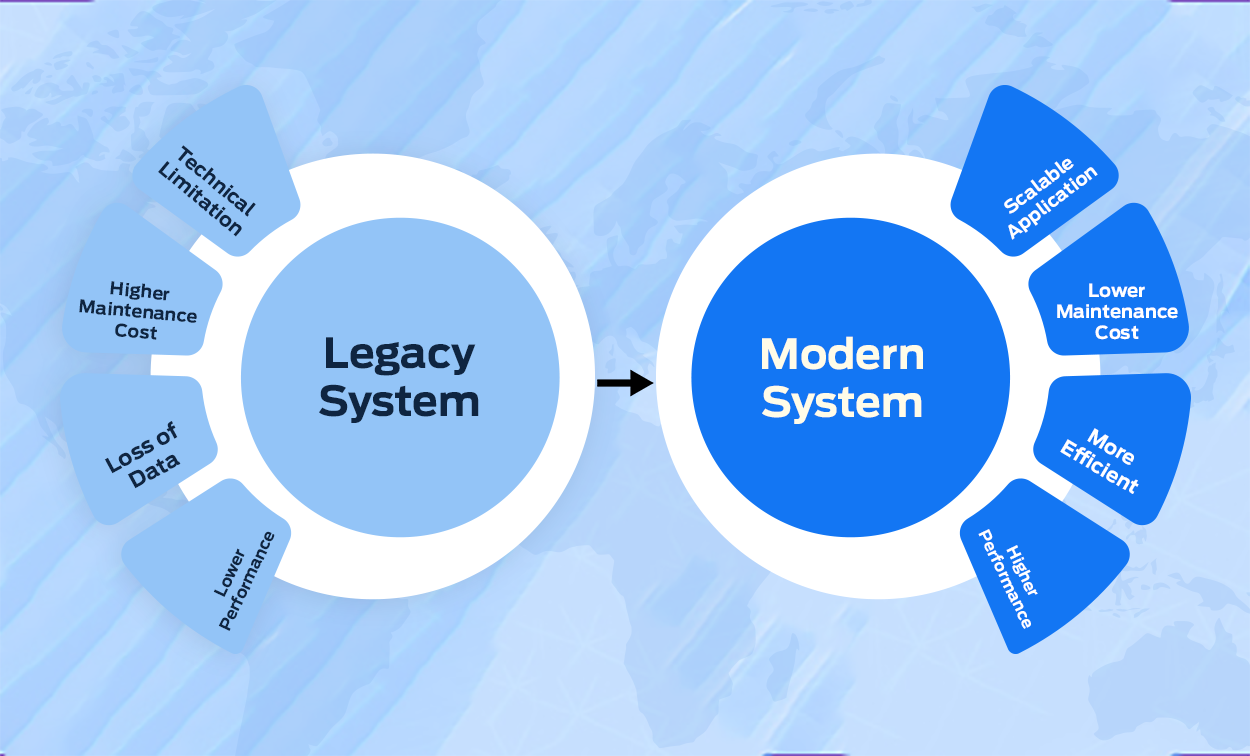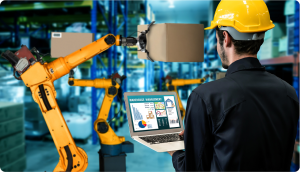
What is legacy system?
Typically, a legacy system is defined as one that has been in operation for a decade or longer. This category encompasses a wide range of technologies, including mainframes, servers, smartphones, Oracle databases, and software suites such as Microsoft Office. Yet many of them continue to be used. This prompts the question: why do organizations persist in using outdated systems when advanced alternatives abound?
Difference between Legacy Modernization and Legacy Application Modernization
“Legacy modernization” vs “Legacy application modernization”, both are related concepts but have slightly different scopes:
Legacy Modernization:
Legacy modernization is a broad term that encompasses the process of updating or upgrading any legacy system, which can include not only applications but also hardware, databases, and infrastructure. It is a comprehensive approach to bring an organization’s outdated technology stack up to date. Legacy modernization can involve replacing or enhancing both applications and the underlying IT environment.
Legacy Application Modernization:
Legacy application modernization, on the other hand, is a subset of legacy modernization that specifically focuses on updating or transforming outdated software applications. It involves improving the functionality, performance, and scalability of existing applications while retaining their core business logic and data. Legacy application modernization typically aims to make legacy applications more compatible with modern technology platforms, improve user experiences, and reduce maintenance costs.
The Dilemma of Legacy Systems
The maintenance costs of legacy systems, often referred to as “legacy costs,” can become substantial as these systems age. Keeping them operational and secure can strain IT budgets and human resources. Security vulnerabilities also become a concern as legacy systems may no longer receive updates and patches from vendors.
Given these challenges, the decision to move towards legacy modernization becomes imperative for many organizations. Modernization involves upgrading or replacing legacy systems with contemporary technology solutions that offer greater flexibility, scalability, and security. This transition allows businesses to stay competitive in a rapidly evolving digital landscape, improve efficiency, and better serve their customers.
5 Hidden Costs of Maintaining Legacy Systems
So, with all the advantages that updating to newer technology offers, why do some companies still resist the change? The reason often boils down to an increase in investment of time and money. Legacy modernization often comes at a price and can take a significant time for teams to understand and implement correctly. But does this short-term investment lead to long-term rewards? Here’s how legacy costs can put your company at a serious disadvantage.
1. Legacy systems might cost more in the long run
While many companies stave off legacy software modernization because of the cost associated with them, ironically, the cost of maintaining legacy systems can actually be higher. Legacy systems usually require more maintenance and might require more frequent changes of hardware. All of this can add up to an increased spending on IT hours, vendors and suppliers. Weighed side-by-side, new technological systems can work out to be a lot more cost-effective than their antiquated counterparts.
In 2022, U.S. expenditures for technology, encompassing products, services, and personnel, reached an estimated $2 trillion. Using a conservative estimate, over $1.14 trillion of these funds were allocated to the maintenance of existing IT assets, including legacy systems.
2. They are more vulnerable to security threats
These days, there is an increased focus on cybersecurity. New legislation such as GDPR have placed huge penalties in case of cybersecurity breaches and data leaks. Most legacy systems are simply not equipped to provide adequate protection against malicious attacks. There are two major reasons for this.
- First, older legacy systems often carry decades of data which are a treasure trove for any hacker. This makes these systems more likely to be a target for attacks.
- Second, the security of software is maintained through continuous security updates.
When a legacy software system becomes outdated, the software maintenance team will stop creating and sending updates. This can leave legacy systems wide open for a cyberattack.
3. They are often incompatible with mobile technology
Most legacy systems were developed during a time when desktops were still the primary way to access the internet and mobiles contributed to a significant (in some cases, non-existent) portion. Today, of course, this scenario has completely reversed. A huge majority of consumers are now accessing the internet through their phone. The extent to which their experience with a company’s online presence is positive, largely depends upon how seamless the mobile interface is
Most legacy systems are ill-equipped to cater to the mobile-first consumer. As a result, without legacy system modernization, your company could be facing a large drop-off in consumers because of a poor mobile user experience. This will ultimately translate into lost revenue opportunities.
4. They can be very time-consuming to use
Apart from the cost of maintaining legacy systems, legacy software systems are often plagued with issues of speed and agility. Companies who are dependent on these are all too familiar with the long time it can take to upload or retrieve data, perform a backup or extrapolate insights and reports. The total time taken by legacy systems can be a serious drain on a company’s resources.
The cumulative time lost due to inefficient technology can prevent your team from focusing on value-driven tasks that can improve your company’s performance. In comparison, the total time taken by teams to learn and adapt to legacy modernization can be much less. New systems also promise much faster processing, cutting down the total time spent on these systems by an even greater number.
5. They are difficult to integrate with modern technology
In an effort to take the middle road, many companies often try to adopt certain types of new technological innovations while still maintaining legacy software as their backbone. While theoretically, this type of legacy system migration might sound like it offers the best of both worlds, in reality it’s a lot more complex.
Moving legacy systems to the cloud is not straightforward. It will need several upgrades to transfer these applications. It will require rehosting, Re-platforming and rearchitecting or redeveloping the application.
Most legacy software is incompatible with new technology. Because of this, staying loyal to your legacy systems might mean having to forego modern technology almost completely. This can put you at a serious disadvantage when compared to your competitors who might have already made the switch successfully. If competitor brands are offering a smoother user experience, higher security and are simultaneously driving revenue through more efficient operations, your company might be unable to close the widening gap by sticking to legacy systems.
Modernize your Legacy System
Legacy system migration can be intimidating for companies as it means letting go of systems that have been in place for decades. But when the trade-off of legacy modernization is more agile systems, higher efficiency and greater opportunities for revenue generation, it becomes clear that the switch is well worth the effort.
iTech has been providing customized software modernization solutions since 2003. We specialize in custom software development, app development and re-engineering. Contact us today to know more about how we can bring value to your business process.







